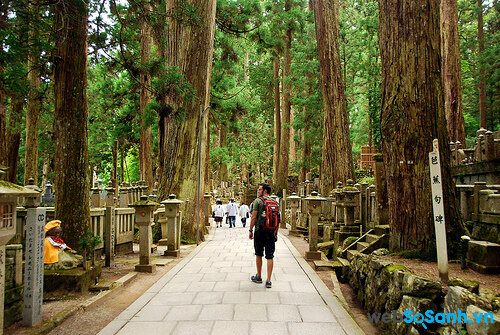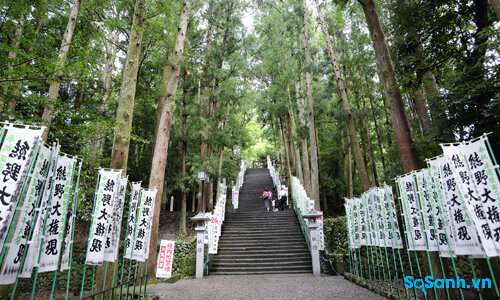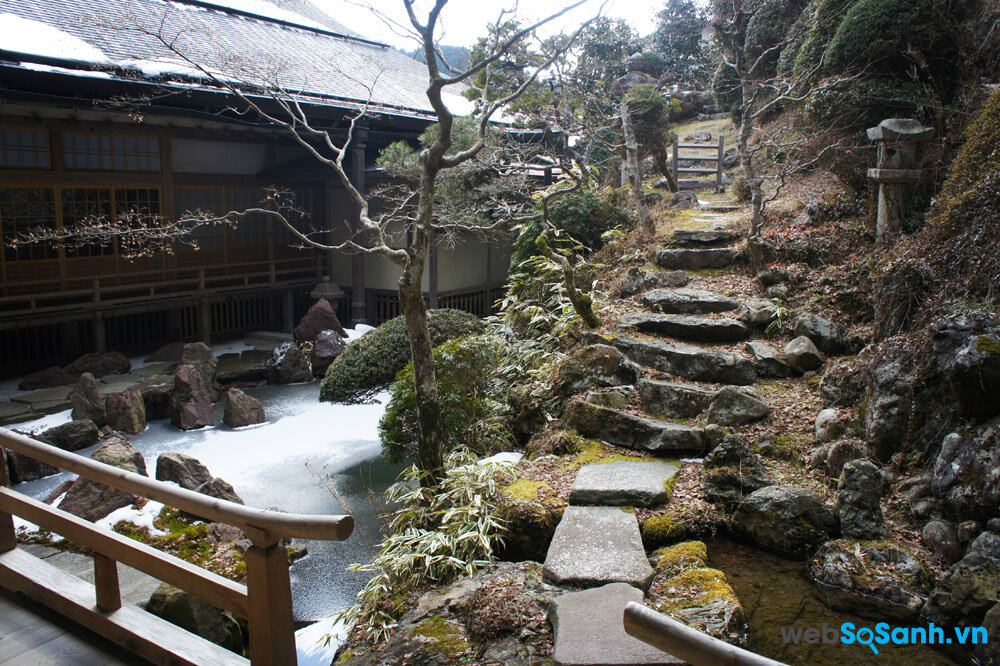Not only is the place of sacred Buddha Dharma, the following destinations are also beautiful and valuable historical landscapes with preserved relics for centuries.
If you want to enjoy beer at lunch, you should go to Asahi or Kirin.
Imagine that you are sitting on a beautiful mattress and enjoying the eye -catching specialty vegetable Shojin Ryori at an ancient temple on the most beautiful mountain in Japan Koyasan. It was not surprising that Fudoin temples accepted that tourists stayed at the temple and enjoyed dinner with wine.
The rules in Buddhism in Japan are not strict as the Buddhist worshiping places in Thailand or Bhutan, when drinking alcohol near the temple is prohibited. One point is equally surprising in Japan that the monks in the temple can get married.

Auto Amazon Links: No products found.
CeraVe Moisturizing Cream, Body and Face Moisturizer for Dry Skin, Body Cream with Hyaluronic Acid and Ceramides, Daily Moisturizer, Oil-Free, Fragrance Free, Non-Comedogenic, 19 Ounce
$17.78 (as of March 6, 2025 05:12 GMT +00:00 - More infoProduct prices and availability are accurate as of the date/time indicated and are subject to change. Any price and availability information displayed on [relevant Amazon Site(s), as applicable] at the time of purchase will apply to the purchase of this product.)Dove Men + Care Antiperspirant Deodorant, 72hr Sweat & Odor Protection, Vitamin E, Triple Moisturizer, 4 Pack
$18.48 (as of March 6, 2025 05:12 GMT +00:00 - More infoProduct prices and availability are accurate as of the date/time indicated and are subject to change. Any price and availability information displayed on [relevant Amazon Site(s), as applicable] at the time of purchase will apply to the purchase of this product.)CeraVe Daily Moisturizing Lotion for Dry Skin, Body Lotion & Face Moisturizer with Hyaluronic Acid and Ceramides, Daily Moisturizer, Fragrance Free, Oil-Free, 12 Ounce
$13.19 (as of March 6, 2025 05:12 GMT +00:00 - More infoProduct prices and availability are accurate as of the date/time indicated and are subject to change. Any price and availability information displayed on [relevant Amazon Site(s), as applicable] at the time of purchase will apply to the purchase of this product.)Neutrogena Makeup Remover Wipes, Daily Facial Cleanser Towelettes, Gently Cleanse and Remove Oil & Makeup, Alcohol-Free Makeup Wipes, 2 x 25 ct
$9.97 (as of March 6, 2025 05:12 GMT +00:00 - More infoProduct prices and availability are accurate as of the date/time indicated and are subject to change. Any price and availability information displayed on [relevant Amazon Site(s), as applicable] at the time of purchase will apply to the purchase of this product.)Schick Hydro Silk Touch-Up Dermaplaning Tool with Precision Cover, 3ct | Dermaplane Razor, Face Razors for Women, Eyebrow Razor, Facial Razor, Dermaplaning Razor, Womens Face Razor Peach Fuzz Remover
$5.94 (as of March 6, 2025 05:12 GMT +00:00 - More infoProduct prices and availability are accurate as of the date/time indicated and are subject to change. Any price and availability information displayed on [relevant Amazon Site(s), as applicable] at the time of purchase will apply to the purchase of this product.)According to history records, in 1872, the Meiji government declared that the monks were free to eat meat without being considered Pham Le, if they were married and had children. This tradition is still kept until now and has never been destroyed.
Seion’s father was a monk at Fudoin Pagoda, who followed his grandfather who also became a monk at this temple, his father’s career and one of the specific points of the temples in Japan.
In Koyasan, there are 117 temples, and Fudoin is one of 52 temples welcoming guests at night.
Located in Wakayama, Koyasan are places not to be missed when coming to Japan famous for the sacred Buddhism.
The popularity of the temple started in 2004 when this landmark was on the list of UNESCO’s world heritage as one of the three most sacred places in the Kii mountain range of Japan.
With a population of nearly 3,000 people, the temple is the holy place of Buddhism in Shingon, a mysterious sect from China introduced in Japan in 805 with a man named Kobo Daishi, or Kukai , one of Japan’s most revered religious characters.
The area around the temple are ancient forests and tiled roads, restaurants, schools, cafes and souvenir shops along the road.
Anything built in the town of Koyasan needs the protection of the government in Kongobuji, these places have the function of the central agency of Shingon Buddhism of more than 4,000 temples and pagodas across Japan. and abroad.
The Ton Venerable Roads
In a remote place in an ancient forest and sacred mountain range, Koyasan is the most beautiful place in the world.
Each temple and the temple gate are silver by the intense sun and rain, especially the architectural systems at Danjo Garan, often described as the second sacred place in Koyasan.
Another beautiful landscape cannot be ignored is Banryutei, the largest stone garden in Japan. This stone garden was located at the Kongobuji temple, it was completed in 1984 to commemorate the 1150th anniversary of the development of great meditation.

The Ordinary Glycolic Acid 7% Exfoliating Toner, Brightening and Smoothing Daily Toner for More Even-Looking Skin Tone
$13.00 (as of March 6, 2025 05:12 GMT +00:00 - More infoProduct prices and availability are accurate as of the date/time indicated and are subject to change. Any price and availability information displayed on [relevant Amazon Site(s), as applicable] at the time of purchase will apply to the purchase of this product.)CeraVe Daily Moisturizing Lotion for Dry Skin, Body Lotion & Face Moisturizer with Hyaluronic Acid and Ceramides, Daily Moisturizer, Fragrance Free, Oil-Free, 12 Ounce
$13.19 (as of March 6, 2025 05:12 GMT +00:00 - More infoProduct prices and availability are accurate as of the date/time indicated and are subject to change. Any price and availability information displayed on [relevant Amazon Site(s), as applicable] at the time of purchase will apply to the purchase of this product.)Boka Fluoride Free Toothpaste Nano Hydroxyapatite, Helps Remineralize, Appropriate for Sensitive Teeth, Whitening - for Adult, Kids Oral Care - Ela Mint Flavor, 4 Fl Oz 1Pk US Manufactured
$11.99 (as of March 6, 2025 05:12 GMT +00:00 - More infoProduct prices and availability are accurate as of the date/time indicated and are subject to change. Any price and availability information displayed on [relevant Amazon Site(s), as applicable] at the time of purchase will apply to the purchase of this product.)DenTek Triple Clean Advanced Clean Floss Picks, No Break & No Shred Floss, 150 Count, (Packaging May Vary)
$3.82 (as of March 6, 2025 05:12 GMT +00:00 - More infoProduct prices and availability are accurate as of the date/time indicated and are subject to change. Any price and availability information displayed on [relevant Amazon Site(s), as applicable] at the time of purchase will apply to the purchase of this product.)Crest 3D White Advanced Luminous Mint Teeth Whitening Toothpaste, Crest Toothpaste, 3.7 oz Pack of 4 - Helps Remove Surface Stains, Whitens Teeth, Strengthens Tooth Enamel, Protects Against Cavities
$14.99 (as of March 6, 2025 05:12 GMT +00:00 - More infoProduct prices and availability are accurate as of the date/time indicated and are subject to change. Any price and availability information displayed on [relevant Amazon Site(s), as applicable] at the time of purchase will apply to the purchase of this product.)Next, the peak of the trip at Koyasan is Okunoin, the most revered place in the stops.
After crossing Ichinohashi, the first bridge, I was ready to go down the hill slope about 2 km of the rocky road to Okunoin and Torodo Hall full of 10,000 beautiful lanterns.
The path is paved with 200,000 paved stones, statues and symbolic objects. The space also has the Shinto Torii gate, the trail and the dense forest with the great trees that seem to shade a cool sky in the clear sunshine of the early morning.
You can walk through this forest hundreds of times and still notice the differences as never before.
Free meditation and wifi
Tourists are given the introduction of a part of the monument and they want to visit.
After that, visitors will be served breakfast, a fresh meal with Shojin Ryori, you will probably give up the meat if you are served this dish every day. This is part of the Koyasan’s secret of living, the ability to accept the change while still closely associated with the core principles of belief in Buddhism.

eos Shea Better Body Lotion- Vanilla Cashmere, 24-Hour Moisture Skin Care, Lightweight & Non-Greasy, Made with Natural Shea, Vegan, 16 fl oz
$8.98 (as of March 6, 2025 05:12 GMT +00:00 - More infoProduct prices and availability are accurate as of the date/time indicated and are subject to change. Any price and availability information displayed on [relevant Amazon Site(s), as applicable] at the time of purchase will apply to the purchase of this product.)MRS. MEYER'S CLEAN DAY Hand Soap, Made with Essential Oils, Biodegradable Formula, Rain Water, 12.5 fl. oz - Pack of 3
$14.34 (as of March 6, 2025 05:12 GMT +00:00 - More infoProduct prices and availability are accurate as of the date/time indicated and are subject to change. Any price and availability information displayed on [relevant Amazon Site(s), as applicable] at the time of purchase will apply to the purchase of this product.)CeraVe Hydrating Facial Cleanser, Moisturizing Face Wash For Dry Skin, Hyaluronic Acid + Ceramides + Glycerin, Hydrating Cleanser For Normal To Dry Skin, National Eczema Association Certified
$14.79 (as of March 6, 2025 05:12 GMT +00:00 - More infoProduct prices and availability are accurate as of the date/time indicated and are subject to change. Any price and availability information displayed on [relevant Amazon Site(s), as applicable] at the time of purchase will apply to the purchase of this product.)SALT & STONE Deodorant | Extra Strength Natural Deodorant for Women & Men | Aluminum Free with Seaweed Extracts, Shea Butter & Probiotics | Free From Parabens, Sulfates & Phthalates (2.6 oz)
$20.00 (as of March 6, 2025 05:12 GMT +00:00 - More infoProduct prices and availability are accurate as of the date/time indicated and are subject to change. Any price and availability information displayed on [relevant Amazon Site(s), as applicable] at the time of purchase will apply to the purchase of this product.)PanOxyl Acne Foaming Wash Benzoyl Peroxide 10% Maximum Strength Antimicrobial, 5.5 Oz
$9.77 (as of March 6, 2025 05:12 GMT +00:00 - More infoProduct prices and availability are accurate as of the date/time indicated and are subject to change. Any price and availability information displayed on [relevant Amazon Site(s), as applicable] at the time of purchase will apply to the purchase of this product.)This is the mission of monks when preserving ancient customs and traditions and helps them exist life.
But even so, new technologies and advanced science are still things that need to be held by understanding, Koyasan is introduced by a person who has been traveling by walking everywhere to spread about. This sacred place.
Nowadays, technology has made information sharing a lot easier, in addition, the truth is that foreign visitors travel to have access to the Internet with many different purposes such as contacting. Family or booking at the hotel …
Accommodation
All temples in Koyasan can be booked through Shukubo Koyasan website.
The level of amenities, and the price is also very diverse, in Fudoin, there are 22 Japanese -style living rooms and two large halls. The room is comfortable and spacious, some rooms have windows overlooking the beautiful garden.
Infrastructure here includes gardens, tea rooms, libraries, European -style bathrooms, shared bathrooms.
In addition, for those who pray in the morning, the activities of tourists include “Sutra Copying”, which means the 262 words with Hanya Shinkyo and the Ajikan meditation.
According to CNN
Hong Hanh
Websosanh.vn – The first price comparison website in Vietnam



















































































































